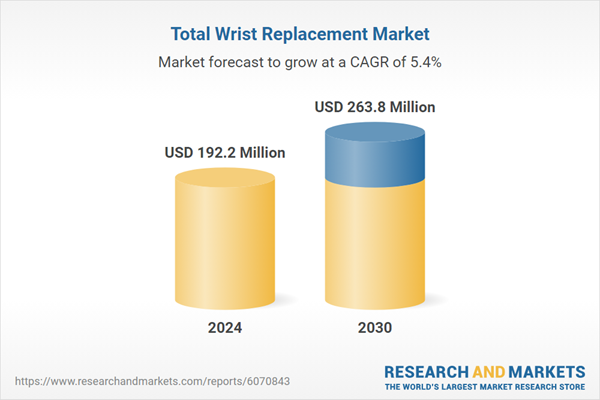Total Wrist Replacement Market Trends & Drivers Summarized
How Is Total Wrist Replacement Transforming Orthopedic and Rheumatology Treatment?
Total wrist replacement (TWR), also known as total wrist arthroplasty (TWA), is revolutionizing the management of severe wrist arthritis and joint degeneration by preserving mobility while alleviating chronic pain. Traditionally, wrist fusion (arthrodesis) was the standard treatment for advanced wrist arthritis, but it results in complete loss of motion, impacting daily activities and quality of life. TWR offers an alternative by maintaining wrist movement, allowing patients to regain functional independence. The rising prevalence of rheumatoid arthritis, post-traumatic osteoarthritis, and degenerative joint diseases is driving demand for total wrist replacement surgeries. Additionally, improvements in implant design, surgical techniques, and post-operative rehabilitation are enhancing patient outcomes, making the procedure more viable for a broader patient demographic. However, challenges such as implant longevity, surgical complexity, and limited awareness among both patients and healthcare providers remain obstacles to widespread adoption. As wrist arthroplasty continues to evolve, how will innovations in biomaterials, biomechanics, and robotic-assisted surgery improve the long-term success of total wrist replacement?What Technological Innovations Are Advancing Total Wrist Replacement?
Recent advancements in total wrist replacement are focused on improving implant longevity, reducing complications, and enhancing patient-specific treatment options. Modern wrist implants are now designed with cobalt-chromium, titanium alloys, and advanced polyethylene components, reducing wear and increasing durability. 3D-printing technology is allowing for the development of patient-specific implants, optimizing anatomical fit and biomechanical function. AI-powered preoperative planning and robotic-assisted surgery are improving surgical precision, ensuring proper implant positioning, and reducing complications such as loosening and implant failure. Additionally, bioactive coatings on implants are promoting osseointegration, improving stability, and reducing post-surgical infection risks. These innovations are making TWR a more reliable and long-lasting solution for patients suffering from debilitating wrist conditions.Why Is the Demand for Total Wrist Replacement Increasing?
The increasing prevalence of arthritis and joint degeneration, particularly among aging populations, is driving demand for wrist arthroplasty procedures. Patients with severe wrist pain who wish to maintain joint mobility are increasingly opting for TWR over traditional fusion procedures. The growing emphasis on early intervention and joint-preserving surgeries is further fueling adoption. Additionally, advancements in rehabilitation protocols and post-operative care are improving long-term patient satisfaction, encouraging more orthopedic surgeons to offer TWR as a viable alternative to fusion.What Factors Are Driving the Growth of the Total Wrist Replacement Market?
The total wrist replacement market is expanding due to improvements in implant materials and surgical techniques, increasing demand for motion-preserving arthritis treatments, rising adoption of 3D-printed patient-specific implants, and growing awareness of wrist arthroplasty as a viable alternative to fusion. As orthopedic technology continues to advance, total wrist replacement is expected to become more widely adopted, offering improved mobility and pain relief for patients with severe wrist conditions.Report Scope
The report analyzes the Total Wrist Replacement market, presented in terms of market value (US$). The analysis covers the key segments and geographic regions outlined below:- Segments: Fixation Type (Cemented, Cementless, Hybrid, Reverse Hybrid); End-Use (Hospitals, Orthopedic Clinics, Others).
- Geographic Regions/Countries: World; United States; Canada; Japan; China; Europe (France; Germany; Italy; United Kingdom; Spain; Russia; and Rest of Europe); Asia-Pacific (Australia; India; South Korea; and Rest of Asia-Pacific); Latin America (Argentina; Brazil; Mexico; and Rest of Latin America); Middle East (Iran; Israel; Saudi Arabia; United Arab Emirates; and Rest of Middle East); and Africa.
Key Insights:
- Market Growth: Understand the significant growth trajectory of the Cemented Fixation segment, which is expected to reach US$103.3 Million by 2030 with a CAGR of a 4.9%. The Cementless Fixation segment is also set to grow at 4.6% CAGR over the analysis period.
- Regional Analysis: Gain insights into the U.S. market, valued at $52.4 Million in 2024, and China, forecasted to grow at an impressive 8.5% CAGR to reach $52.6 Million by 2030. Discover growth trends in other key regions, including Japan, Canada, Germany, and the Asia-Pacific.
Why You Should Buy This Report:
- Detailed Market Analysis: Access a thorough analysis of the Global Total Wrist Replacement Market, covering all major geographic regions and market segments.
- Competitive Insights: Get an overview of the competitive landscape, including the market presence of major players across different geographies.
- Future Trends and Drivers: Understand the key trends and drivers shaping the future of the Global Total Wrist Replacement Market.
- Actionable Insights: Benefit from actionable insights that can help you identify new revenue opportunities and make strategic business decisions.
Key Questions Answered:
- How is the Global Total Wrist Replacement Market expected to evolve by 2030?
- What are the main drivers and restraints affecting the market?
- Which market segments will grow the most over the forecast period?
- How will market shares for different regions and segments change by 2030?
- Who are the leading players in the market, and what are their prospects?
Report Features:
- Comprehensive Market Data: Independent analysis of annual sales and market forecasts in US$ Million from 2024 to 2030.
- In-Depth Regional Analysis: Detailed insights into key markets, including the U.S., China, Japan, Canada, Europe, Asia-Pacific, Latin America, Middle East, and Africa.
- Company Profiles: Coverage of players such as Acumed, LLC, Allegra Orthopaedics, Arthrex, Inc., Biomet, Inc. (Zimmer Biomet), Colfax Corporation (Enovis) and more.
- Complimentary Updates: Receive free report updates for one year to keep you informed of the latest market developments.
Some of the 42 companies featured in this Total Wrist Replacement market report include:
- Acumed LLC
- Anika Therapeutics Inc.
- Arthrex, Inc.
- Biomet Orthopedics (Zimmer Biomet)
- CONMED Corporation
- Corin Group
- DePuy Synthes (Johnson & Johnson)
- DJO, LLC (Enovis)
- Extremity Medical
- Fibioseq Medical Ltd
- Integra LifeSciences Corporation
- Johnson & Johnson (DePuy Synthes)
- KLS Martin LP
- Medartis AG
- MicroPort Orthopedics, Inc.
- Skeletal Dynamics
- Small Bone Innovations, Inc.
- Smith & Nephew plc
- Stryker Corporation
- Wright Medical Group N.V.
- Zimmer Biomet Holdings, Inc.
This edition integrates the latest global trade and economic shifts into comprehensive market analysis. Key updates include:
- Tariff and Trade Impact: Insights into global tariff negotiations across 180+ countries, with analysis of supply chain turbulence, sourcing disruptions, and geographic realignment. Special focus on 2025 as a pivotal year for trade tensions, including updated perspectives on the Trump-era tariffs.
- Adjusted Forecasts and Analytics: Revised global and regional market forecasts through 2030, incorporating tariff effects, economic uncertainty, and structural changes in globalization. Includes historical analysis from 2015 to 2023.
- Strategic Market Dynamics: Evaluation of revised market prospects, regional outlooks, and key economic indicators such as population and urbanization trends.
- Innovation & Technology Trends: Latest developments in product and process innovation, emerging technologies, and key industry drivers shaping the competitive landscape.
- Competitive Intelligence: Updated global market share estimates for 2025, competitive positioning of major players (Strong/Active/Niche/Trivial), and refined focus on leading global brands and core players.
- Expert Insight & Commentary: Strategic analysis from economists, trade experts, and domain specialists to contextualize market shifts and identify emerging opportunities.
Table of Contents
Companies Mentioned (Partial List)
A selection of companies mentioned in this report includes, but is not limited to:
- Acumed LLC
- Anika Therapeutics Inc.
- Arthrex, Inc.
- Biomet Orthopedics (Zimmer Biomet)
- CONMED Corporation
- Corin Group
- DePuy Synthes (Johnson & Johnson)
- DJO, LLC (Enovis)
- Extremity Medical
- Fibioseq Medical Ltd
- Integra LifeSciences Corporation
- Johnson & Johnson (DePuy Synthes)
- KLS Martin LP
- Medartis AG
- MicroPort Orthopedics, Inc.
- Skeletal Dynamics
- Small Bone Innovations, Inc.
- Smith & Nephew plc
- Stryker Corporation
- Wright Medical Group N.V.
- Zimmer Biomet Holdings, Inc.
Table Information
| Report Attribute | Details |
|---|---|
| No. of Pages | 282 |
| Published | December 2025 |
| Forecast Period | 2024 - 2030 |
| Estimated Market Value ( USD | $ 192.2 Million |
| Forecasted Market Value ( USD | $ 263.8 Million |
| Compound Annual Growth Rate | 5.4% |
| Regions Covered | Global |









